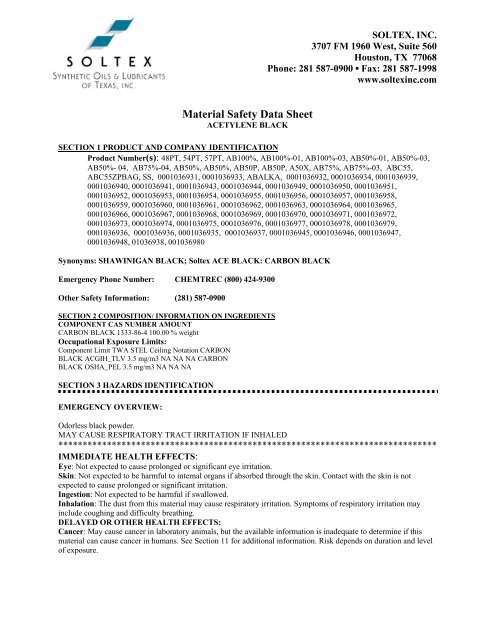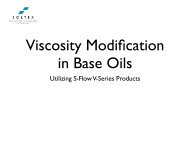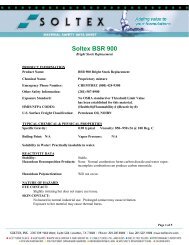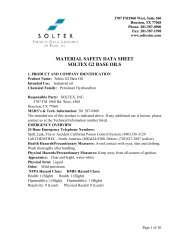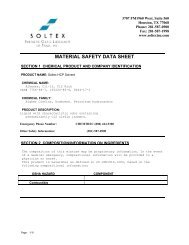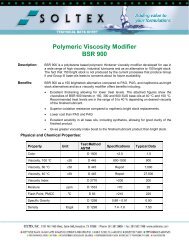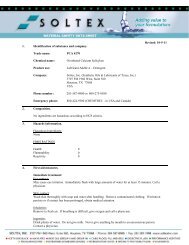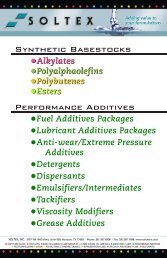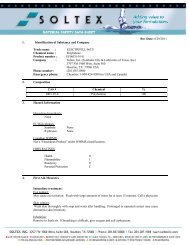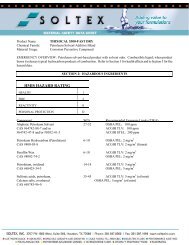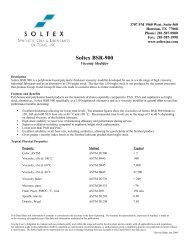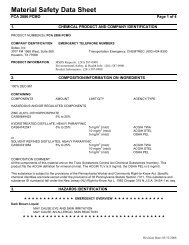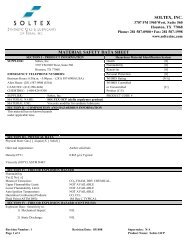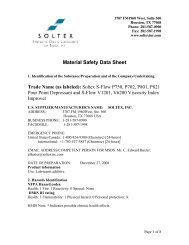Material Safety Data Sheet - Soltex
Material Safety Data Sheet - Soltex
Material Safety Data Sheet - Soltex
You also want an ePaper? Increase the reach of your titles
YUMPU automatically turns print PDFs into web optimized ePapers that Google loves.
SOLTEX, INC.<br />
3707 FM 1960 West, Suite 560<br />
Houston, TX 77068<br />
Phone: 281 587-0900 ▪ Fax: 281 587-1998<br />
www.soltexinc.com<br />
<strong>Material</strong> <strong>Safety</strong> <strong>Data</strong> <strong>Sheet</strong><br />
ACETYLENE BLACK<br />
SECTION 1 PRODUCT AND COMPANY IDENTIFICATION<br />
Product Number(s): 48PT, 54PT, 57PT, AB100%, AB100%-01, AB100%-03, AB50%-01, AB50%-03,<br />
AB50%- 04, AB75%-04, AB50%, AB50%, AB50P, AB50P, A50X, AB75%, AB75%-03, ABC55,<br />
ABC55ZPBAG, SS, 0001036931, 0001036933, ABALKA, 0001036932, 0001036934, 0001036939,<br />
0001036940, 0001036941, 0001036943, 0001036944, 0001036949, 0001036950, 0001036951,<br />
0001036952, 0001036953, 0001036954, 0001036955, 0001036956, 0001036957, 0001036958,<br />
0001036959, 0001036960, 0001036961, 0001036962, 0001036963, 0001036964, 0001036965,<br />
0001036966, 0001036967, 0001036968, 0001036969, 0001036970, 0001036971, 0001036972,<br />
0001036973, 0001036974, 0001036975, 0001036976, 0001036977, 0001036978, 0001036979,<br />
0001036936, 0001036936, 0001036935, 0001036937, 0001036945, 0001036946, 0001036947,<br />
0001036948, 01036938, 001036980<br />
Synonyms: SHAWINIGAN BLACK; <strong>Soltex</strong> ACE BLACK: CARBON BLACK<br />
Emergency Phone Number: CHEMTREC (800) 424-9300<br />
Other <strong>Safety</strong> Information: (281) 587-0900<br />
SECTION 2 COMPOSITION/ INFORMATION ON INGREDIENTS<br />
COMPONENT CAS NUMBER AMOUNT<br />
CARBON BLACK 1333-86-4 100.00 % weight<br />
Occupational Exposure Limits:<br />
Component Limit TWA STEL Ceiling Notation CARBON<br />
BLACK ACGIH_TLV 3.5 mg/m3 NA NA NA CARBON<br />
BLACK OSHA_PEL 3.5 mg/m3 NA NA NA<br />
SECTION 3 HAZARDS IDENTIFICATION<br />
EMERGENCY OVERVIEW:<br />
Odorless black powder.<br />
MAY CAUSE RESPIRATORY TRACT IRRITATION IF INHALED<br />
******************************************************************************<br />
IMMEDIATE HEALTH EFFECTS:<br />
Eye: Not expected to cause prolonged or significant eye irritation.<br />
Skin: Not expected to be harmful to internal organs if absorbed through the skin. Contact with the skin is not<br />
expected to cause prolonged or significant irritation.<br />
Ingestion: Not expected to be harmful if swallowed.<br />
Inhalation: The dust from this material may cause respiratory irritation. Symptoms of respiratory irritation may<br />
include coughing and difficulty breathing.<br />
DELAYED OR OTHER HEALTH EFFECTS:<br />
Cancer: May cause cancer in laboratory animals, but the available information is inadequate to determine if this<br />
material can cause cancer in humans. See Section 11 for additional information. Risk depends on duration and level<br />
of exposure.
SOLTEX, INC.<br />
3707 FM 1960 West, Suite 560<br />
Houston, TX 77068<br />
Phone: 281 587-0900 ▪ Fax: 281 587-1998<br />
www.soltexinc.com<br />
SECTION 4 FIRST AID MEASURES<br />
Eye: No specific first aid measures are required because this material is not expected to cause eye irritation. As a<br />
precaution, remove contact lenses, if worn, and flush eyes with water.<br />
Skin: To remove the material from skin, use soap and water. Discard contaminated clothing and shoes or thoroughly<br />
clean before reuse.<br />
Ingestion: If swallowed, do not induce vomiting. Give the person a glass of water or milk to drink and get medical<br />
attention. Never give anything by mouth to an unconscious person.<br />
Inhalation: Move the exposed person to fresh air. If not breathing, give artificial respiration. If breathing is<br />
difficult, give oxygen. Get medical attention if breathing difficulties continue. .<br />
SECTION 5 FIRE FIGHTING MEASURES<br />
The ignition temperature of this material in air is approximately 900C. If ignited, flames may not be visible in the<br />
burning powder. Some heat and smoke may be noticeable. Soaking with water may spread the fire due to the<br />
burning powder floating on the water. High pressure fire extinguishing equipment may blow the burning powder<br />
into other areas resulting in more fires.<br />
RECOMMENDED ACTION: If possible, isolate the burning powder into an open area (preferably outside),<br />
monitor, and allow the fire to burn itself out. Gently applying a fine water mist to the area of the fire may be helpful.<br />
Stop spraying if water starts to puddle. Eliminating the source of oxygen may also be helpful. DO NOT spray with<br />
high pressure fire extinguishers.<br />
NFPA RATINGS: Health:1 Flammability: 1 Reactivity: 0<br />
FLAMMABLE PROPERTIES: Flashpoint: NDA Autoignition: 900°C (1652°F) Flammability (Explosive)<br />
Limits (% by volume in air): Lower: NA Upper:<br />
NA PROTECTION OF FIRE FIGHTERS:<br />
Fire Fighting Instructions: For fires involving this material, do not enter any enclosed or confined fire space<br />
without proper protective equipment, including self-contained breathing apparatus. This material will burn although<br />
it is not easily ignited.<br />
Combustion Products: Normal combustion forms carbon dioxide and water vapor; incomplete combustion can<br />
produce carbon monoxide.<br />
SECTION 6 ACCIDENTAL RELEASE MEASURES<br />
Spill Management: Clean up spills immediately, observing precautions in Exposure Controls/Personal Protection<br />
section. Sweep up material and place in a disposable container.<br />
Reporting: Based on information available to <strong>Soltex</strong>, Inc., this product is neither listed as a hazardous waste nor<br />
does it exhibit any of the characteristics that would cause it to be classified or disposed of as a RCRA hazardous<br />
waste.<br />
SECTION 7 HANDLING AND STORAGE<br />
HANDLING<br />
Technical Measures /Precautions<br />
STORAGE<br />
Technical Measures/Storage Conditions<br />
PACKAGING MATERIALS<br />
Recommended<br />
OTHER INFORMATION<br />
Provide suitable exhaust in work areas if the product is handled in the<br />
open air. Avoid dust suspension in air.<br />
Protect form damp conditions at normal ambient temperatures. Keep<br />
containers tightly sealed.<br />
Multi-ply paper sacks. Keep product in original containers or within<br />
sealed/waterproof hoppers.<br />
A cloud of acetylene black has an explosion index of 0.1 indicating that<br />
no explosion was obtained in the course of trials with flames or electric<br />
sparks.
SOLTEX, INC.<br />
3707 FM 1960 West, Suite 560<br />
Houston, TX 77068<br />
Phone: 281 587-0900 ▪ Fax: 281 587-1998<br />
www.soltexinc.com<br />
SECTION 8 EXPOSURE CONTROLS/PERSONAL PROTECTION<br />
GENERAL CONSIDERATIONS:<br />
Consider the potential hazards of this material (see Section 3), applicable exposure limits, job activities, and other<br />
substances in the work place when designing engineering controls and selecting personal protective equipment. If<br />
engineering controls or work practices are not adequate to prevent exposure to harmful levels of this material, the<br />
personal protective equipment listed below is recommended. The user should read and understand all instructions<br />
and limitations supplied with the equipment since protection is<br />
usually provided for a limited time or under certain circumstances.<br />
PERSONAL PROTECTIVE EQUIPMENT: Eye/Face Protection: No special eye protection is normally required.<br />
Where splashing is possible, wear safety glasses with side shields as a good safety practice. Skin Protection: Wear<br />
impervious protective clothing to prevent skin contact. Selection of protective clothing may include gloves, apron,<br />
boots, and complete facial protection depending on operations conducted. Users should determine acceptable<br />
performance characteristics of protective clothing. Consider physical requirements and other substances present<br />
when selecting protective clothing. Suggested materials for protective gloves include: No skin protection is<br />
ordinarily required under normal conditions of use.<br />
Respiratory Protection: Wear a NIOSH approved respirator that provides protection when working with this material<br />
if exposure to harmful levels of airborne material may occur, such as: Air-Purifying Respirator for Dusts and Mists<br />
Occupational Exposure Limits:<br />
Component Limit TWA STEL Ceiling Notation CARBON<br />
BLACK ACGIH_TLV 3.5 mg/m3 NA NA NA CARBON BLACK<br />
OSHA_PEL 3.5 mg/m3 NA NA NA<br />
SECTION 9 PHYSICAL AND CHEMICAL PROPERTIES APPEARANCE AND ODOR<br />
Odorless black powder. pH: 6.5 - 7.5<br />
VAPOR PRESSURE: NA<br />
VAPOR DENSITY (AIR=1): NA<br />
BOILING POINT: 3500°C (6332°F)<br />
SOLUBILITY: NDA<br />
DENSITY: 1.75 g/cm3<br />
SECTION 10 STABILITY AND REACTIVITY<br />
Chemical Stability: This material is considered stable under normal ambient and anticipated storage and handling<br />
conditions of temperature and pressure. Conditions to Avoid: No <strong>Data</strong> Available Incompatibility With Other<br />
<strong>Material</strong>s: No data available Hazardous Decomposition<br />
Products: No <strong>Data</strong> Available Hazardous Polymerization: Hazardous polymerization will not occur.<br />
SECTION 11 TOXICOLOGICAL INFORMATION IMMEDIATE HEALTH EFFECTS<br />
Acute Oral Toxicity: The oral LD50 is undetermined.<br />
Acute Dermal Toxicity: The dermal LD50 is undetermined.<br />
Eye Irritation: This material is not expected to be irritating to the eyes.<br />
Skin Irritation: This material is not expected to be irritating to the skin.<br />
Respiratory Tract Irritation: This material is a mild irritant to the respiratory tract.<br />
ADDITIONAL TOXICOLOGY INFORMATION:<br />
The International Agency for Research on Cancer (IARC) has classified carbon black as a Group 2B carcinogen<br />
(possibly carcinogenic to humans) based on sufficient evidence in animals and inadequate evidence in humans.<br />
Carbon black has not been listed as a carcinogen by the National Toxicology Program the Occupational <strong>Safety</strong> and<br />
Health Administration. Acetylene black, a high purity carbon black, is made from the thermal decomposition of<br />
acetylene gas. It is a pure form of carbon containing less than 0.2 ppm polycyclic aromatic hydrocarbons (PAHs).<br />
Therefore, acetylene black is not expected to directly interact with DNA to present a cancer risk by skin exposure or<br />
by inhalation. However, chronic inflammation, lung
SOLTEX, INC.<br />
3707 FM 1960 West, Suite 560<br />
Houston, TX 77068<br />
Phone: 281 587-0900 ▪ Fax: 281 587-1998<br />
www.soltexinc.com<br />
fibrosis, and lung tumors have been observed in rats in studies in which rats inhaled carbon black for a lifetime at<br />
concentrations that overwhelmed the lung particle clearance mechanisms and caused the carbon black to accumulate<br />
in the lung. Results of these studies indicate that tumors were caused by the physical effect of overloading the lungs<br />
with particles and suggest that exposures below the exposure limit would not cause adverse health effects. Studies of<br />
workers in the carbon black industry indicate that elevated rates of lung cancer have not been associated with<br />
occupational exposures to carbon black. Studies in Eastern Europe of workers heavily exposed to carbon black<br />
reported respiratory diseases including bronchitis, fibrosis, pneumoconiosis, emphysema, and rhinitis, but not<br />
cancer; however, these studies are of questionable validity, due to inadequate study design and methodology, lack of<br />
appropriate controls for cigarette smoking, and confounding with concurrent exposures to other substances. Studies<br />
of workers in the carbon black production industries of North America and Western Europe show that pulmonary<br />
effects of exposure to carbon black are limited to slight radiological changes in the lung, chronic bronchitis, and<br />
slight reduction in lung function. Tumors induced in rat lungs by carbon black, as well as other biologically inert<br />
particles, under conditions of overload may be rat-specific effects as they are not seen in mice or<br />
hamsters tested under similar conditions or in studies of carbon black workers. We believe that the data<br />
presently available for carbon black do not support a significantly increased risk of cancer or other adverse health<br />
effects for workers when precautions outlined in this document are followed.<br />
SECTION 12 ECOLOGICAL INFORMATION<br />
ECOTOXICITY:<br />
The toxicity of this material to aquatic organisms has not been evaluated. Consequently, this material should be kept<br />
out of sewage and drainage systems and all bodies of water.<br />
ENVIRONMENTAL FATE:<br />
This material is not expected to present an environmental problem.<br />
physical properties and analysis for regulated components may be necessary to make a correct determination. If this<br />
material is classified as a hazardous waste, federal law requires disposal at a licensed hazardous waste disposal<br />
facility.<br />
SECTION 13 DISPOSAL CONSIDERATIONS<br />
Use material for its intended purpose or recycle if possible. This material, if it must be discarded, may meet the<br />
criteria of a hazardous waste as defined by US EPA under RCRA (40 CFR 261) or other State and local regulations.<br />
Measurement of certain physical properties and analysis for regulated components may be necessary to make a<br />
correct determination. If this material is classified as a hazardous waste, federal law requires disposal at a licensed<br />
hazardous waste disposal facility.<br />
SECTION 14 TRANSPORT INFORMATION<br />
The description shown may not apply to all shipping situations. Consult 49CFR, or appropriate Dangerous Goods<br />
Regulations, for additional description requirements (e.g., technical name) and mode-specific or quantity-specific<br />
shipping requirements.<br />
US DOT<br />
NOT REGULATED AS A HAZARDOUS MATERIAL OR DANGEROUS GOODS FOR TRANSPORTATION<br />
ICAO / IATA<br />
NOT REGULATED AS A HAZARDOUS MATERIAL OR DANGEROUS GOODS FOR TRANSPORTATION<br />
IMO / IMDG<br />
NOT REGULATED AS A HAZARDOUS MATERIAL OR DANGEROUS GOODS FOR TRANSPORTATION<br />
RID / ADR<br />
NOT REGULATED AS A HAZARDOUS MATERIAL OR DANGEROUS GOODS FOR TRANSPORTATION<br />
SECTION 15 REGULATORY INFORMATION SARA 311/312 CATEGORIES: 1. Immediate<br />
(Acute) Health Effects: YES<br />
1. 2. Delayed (Chronic) Health Effects: YES<br />
2. 3. Fire Hazard: NO
SOLTEX, INC.<br />
3707 FM 1960 West, Suite 560<br />
Houston, TX 77068<br />
Phone: 281 587-0900 ▪ Fax: 281 587-1998<br />
www.soltexinc.com<br />
3. 4. Sudden Release of Pressure Hazard: NO<br />
4. 5. Reactivity Hazard: NO<br />
REGULATORY LISTS SEARCHED:<br />
04A = IARC Group 1 12 = TSCA Section 8(a) PAIR 21 = TSCA Section 5(a) 04B = IARC Group 2A 13 = TSCA<br />
Section 8(d) 25 = CAA Section 112 HAPs 04C = IARC Group 2B 15 = SARA Section 313 26 = CWA Section 311<br />
05 = NTP Carcinogen 16 = CA Proposition 65 28 = CWA Section 307 06 = OSHA Carcinogen 17 = MA RTK 30 =<br />
RCRA Waste P-List 09 = TSCA 12(b) 18 = NJ RTK 31 = RCRA Waste<br />
U-List 10 = TSCA Section 4 19 = DOT Marine Pollutant 32 = RCRA Appendix VIII 11 = TSCA Section 8(a) CAIR<br />
20 = PA RTK 33 = MN Hazardous Substance.The following components of this material are found on the<br />
regulatory lists indicated. CARBON BLACK 04C, 17, 18, 20, 33<br />
CHEMICAL INVENTORY LISTINGS:<br />
AUSTRALIA: All the components of this material are listed on the Australian Inventory of Chemical Substances<br />
(AICS). CANADA: All the components of this material are on the Canadian Domestic Substances List (DSL).<br />
PEOPLE'S REPUBLIC OF CHINA: All the components of this product are listed on the draft Inventory of Existing<br />
Chemical Substances in China. EUROPEAN UNION: All the components of this material are in compliance with<br />
the EU Seventh Amendment Directive 92/32/EEC.<br />
JAPAN: All the components of this product are on the Existing & New Chemical Substances (ENCS) inventory in<br />
Japan, or have an exemption from listing. KOREA: All the components of this product are on the Existing<br />
Chemicals List (ECL) in Korea.<br />
PHILIPPINES: All the components of this product are listed on the Philippine Inventory of Chemicals and Chemical<br />
Substances (PICCS). UNITED STATES: All of the components of this material are on the Toxic Substances Control<br />
Act (TSCA) Chemical Inventory.<br />
SECTION 16 OTHER INFORMATION NFPA RATINGS<br />
Health: 1 Flammability: 1 Reactivity: 0 (0-Least, 1-Slight, 2-Moderate, 3-High, 4-Extreme, PPE:- Personal<br />
Protection Equipment Index recommendation, *- Chronic Effect Indicator). These values are obtained using the<br />
guidelines or published evaluations prepared by the National Fire Protection Association (NFPA) or the<br />
REVISION STATEMENT: This revision updates the transportation information, please review section 14.<br />
ABBREVIATIONS THAT MAY HAVE BEEN USED IN THIS DOCUMENT: TLV -Threshold Limit Value TWA<br />
- Time Weighted Average STEL -Short-term Exposure Limit PEL - Permissible Exposure Limit ACGIH -American<br />
Conference of Government Industrial Hygienists OSHA - Occupational <strong>Safety</strong> &<br />
Health NIOSH -National Institute of <strong>Safety</strong> & Health NFPA - National Fire Protection Agency WHMIS -Workplace<br />
Hazardous <strong>Material</strong>s Information System IRAC - Intl. Agency for Research on Cancer EINECS -European<br />
Inventory of existing Commercial Chemical Sales RCRA - Resource Conservation Recovery<br />
Act SARA -Superfund Amendments and Reauthorization Act. TSCA - Toxic Substance Control Act EC50 -<br />
Effective Dose LC50 - Lethal Concentration LD50 -Lethal Dose CAS - Chemical Abstract Service<br />
Number NDA -No <strong>Data</strong> Available NA - Not Applicable = - Greater Than or Equal To<br />
CNS -Central Nervous System<br />
Prepared according to the OSHA Hazard Communication Standard (29 CFR 1910.1200) and the ANSI<br />
MSDS Standard (Z400.1) by EHS Product Stewardship Group, <strong>Soltex</strong>, Inc., Houston, TX 77068<br />
The above information is based on the data of which we are aware and is believed to be correct as of the date hereof.<br />
Since this information may be applied under conditions beyond our control and with which we may be unfamiliar<br />
and since data made available subsequent to the date hereof may suggest modifications of the information, we do not<br />
assume any responsibility for the results of its use. This information is furnished upon condition that the person<br />
receiving it shall make his own determination of the suitability of the material for his particular purpose.<br />
REVISED 03/19/10


